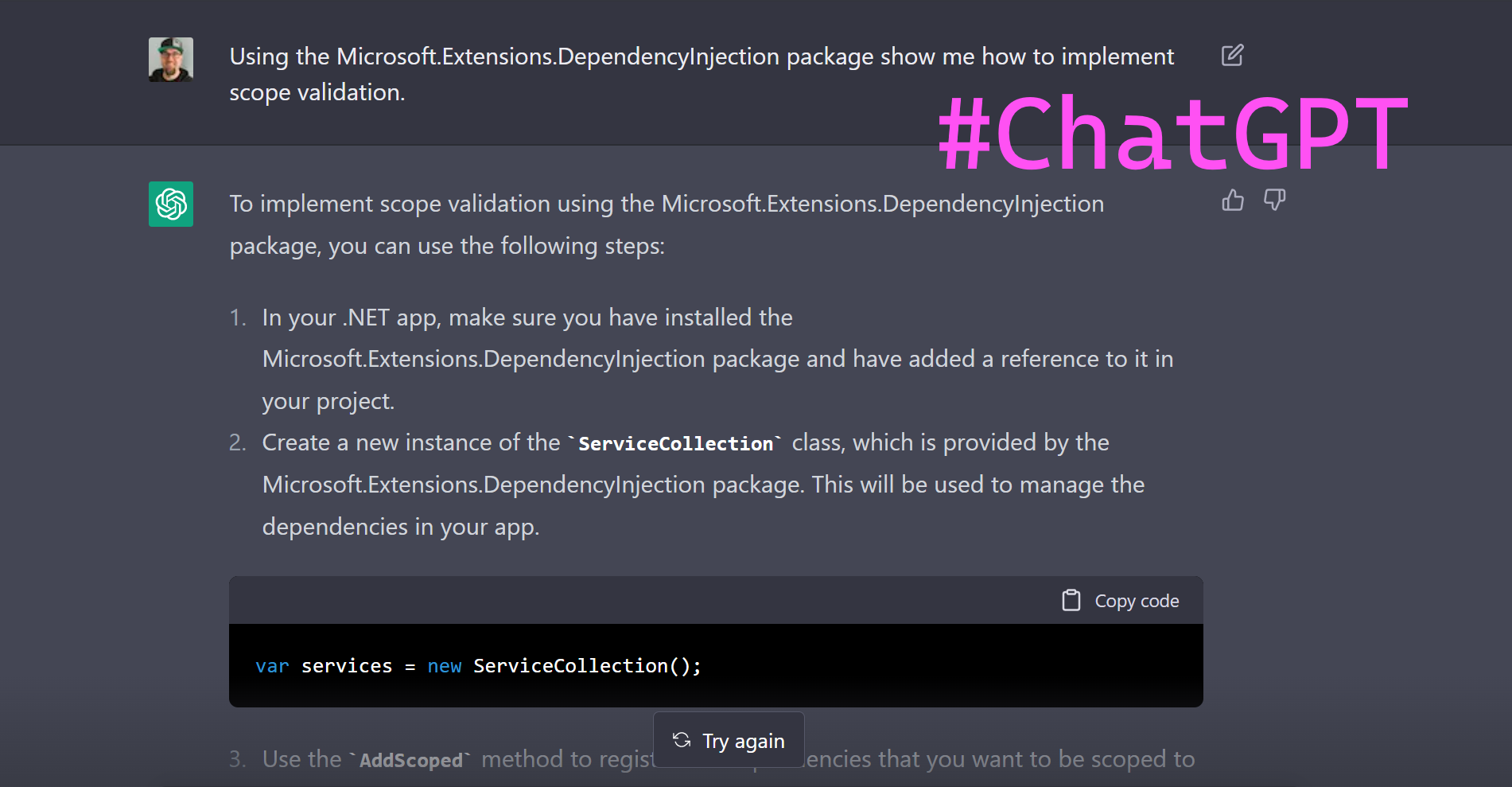A conversation with ChatGPT
Focusing on .NET Dependency Injection

A conversation with ChatGPT about .NET Dependency Injection
What is dependency injection and why is it important?
David Pine
Dependency injection is a software design pattern that allows a programmer to remove hard-coded dependencies and make them configurable. This is important because it makes code more modular and easier to maintain, test, and reuse. Additionally, it makes it possible for different parts of a program to be supplied with the specific dependencies they need, rather than having to rely on a global, static dependency. This can make it easier to manage complex systems and can help to improve the flexibility and scalability of a program.
What’s inversion of control, and how does it relate to the separation of concerns principle?
David Pine
Inversion of control (IoC) is a design principle that specifies that a program should not dictate the behavior of the components it uses. Instead, the program should specify its requirements, and the components should be designed to fulfill those requirements. This means that the program is not in control of how its components are created, how they are initialized, or how they are used.
The separation of concerns principle states that a software program should be divided into distinct sections, each of which addresses a separate concern. By following this principle, a program can be designed in a way that makes it easier to understand, maintain, and extend.
IoC is related to the separation of concerns principle because it helps to achieve a clean separation of concerns within a program. By using IoC, you can design your program in such a way that the various components are not tightly coupled to each other. This makes it easier to change or modify the behavior of a single component without affecting the rest of the program. In this way, IoC helps to promote the separation of concerns, which in turn makes your program more modular and easier to maintain.
When was the concept of dependency injection popularized?
David Pine
The concept of dependency injection has been around for a long time, and it has been recognized as an important technique in software development for many years. However, the term “dependency injection” itself was coined by Martin Fowler in 2004, in an article he wrote for the website of O’Reilly Media. In this article, he explained the concept and discussed its importance in software development, particularly in the context of object-oriented programming. Since then, dependency injection has become a widely used and well-known design pattern in the field of software engineering.
How do you install the dependency injection NuGet package in an existing .NET app?
David Pine
To install the dependency injection NuGet package in an existing .NET app, you can use the following steps:
- Open your app in Visual Studio.
- In the Solution Explorer, right-click on the solution and select “Manage NuGet Packages”.
- In the NuGet Package Manager, search for “Microsoft.Extensions.DependencyInjection”.
- Select the package in the search results and click “Install”.
- Follow the on-screen instructions to complete the installation.
Alternatively, you can use the following command at the command line to install the package:
dotnet add package Microsoft.Extensions.DependencyInjection
Once the package has been installed, you can use the types and methods it provides to implement dependency injection in your app. For more information on how to do this, you can refer to the official Microsoft documentation.
Describe .NET dependency injection with the
David PineMicrosoft.Extensions.DependencyInjectionNuGet package.
The Microsoft.Extensions.DependencyInjection NuGet package is a popular dependency injection framework for the .NET ecosystem. It provides a simple and flexible way to configure and use dependency injection in .NET applications.
To use the Microsoft.Extensions.DependencyInjection package, you first need to add it to your project using the NuGet Package Manager. Once it’s added, you can use the IServiceCollection interface to configure your dependencies. For example, suppose you have an IFoo interface and a Foo class that implements it. To register the Foo class as the implementation of the IFoo interface, you can use the following code:
services.AddTransient<IFoo, Foo>();
This tells the dependency injection framework to create a new instance of the Foo class every time it is needed. Alternatively, you can use the AddSingleton method to register a single shared instance of the Foo class, or the AddScoped method to register an instance that is shared within a single request or unit of work.
Once your dependencies are registered, you can use the IServiceProvider interface to resolve them. This is typically done by creating an instance of the ServiceProvider class, which is passed the IServiceCollection instance that you configured earlier by calling BuildServiceProvider. Then, you can use the GetService method to resolve a specific dependency by its type. For example:
var serviceProvider = services.BuildServiceProvider();
var foo = serviceProvider.GetService<IFoo>();
This will return an instance of the Foo class that you registered earlier. You can then use this instance as you would normally, without having to worry about how it was created or managed.
Using the Microsoft.Extensions.DependencyInjection package can make it easier to manage dependencies in your .NET applications. It provides a simple and flexible way to configure and use dependency injection, allowing you to improve the maintainability and testability of your code.
What is scope validation and why is it important when using the
David PineMicrosoft.Extensions.DependencyInjectionNuGet package?
Scope validation is a feature of the Microsoft.Extensions.DependencyInjectionNuGet package that helps ensure that the objects created by the dependency injection container are used correctly. It does this by checking that an object is only used within the scope in which it was created. This is important because it helps prevent issues such as using an object after it has been disposed, or using an object from the wrong thread. By using scope validation, you can catch such errors early on and avoid potential runtime issues.
Why is scope validation important in dependency injection?
David Pine
Scope validation is important in dependency injection because it allows you to ensure that the dependencies in your app are being used correctly. In particular, it helps you to verify that the dependencies have the correct scope, which is the lifetime of the dependency in your app.
When you register a dependency in your app, you can specify its scope by using one of the Add methods provided by the IServiceCollection interface. For example, you can use the AddScopedmethod to specify that the dependency should be scoped to a specific instance, such as a request in an ASP.NET app.
If you do not specify the scope of a dependency, it will be registered with the default scope, which is Transient. This means that a new instance of the dependency will be created each time it is requested.
If you register a dependency with the wrong scope, it can cause problems in your app. For example, if you register a dependency with a Transient scope but it should be Scoped, it will create a new instance of the dependency each time it is requested, which can cause unexpected behavior and may lead to performance issues.
Scope validation allows you to verify that all the registered dependencies have the correct scope, so you can catch and fix any issues before they cause problems in your app. This can help to improve the reliability and performance of your app.
Conclusion
There were very few corrections that I had to make when pasting in the responses from ChatGPT. I think this is a testament to the quality of the responses that ChatGPT was able to generate. I think this is a testament to the quality of the training data that ChatGPT was trained on. This technology has inspired so many new ideas and ways of reimagining what’s possible with AI. I’m not only excited to see what the future holds, but I’m also optimistically cautious.
For additional reading, see the official Microsoft docs on dependency injection , and be sure to check out ChatGPT from OpenAI.







Share this post
Sponsor
Twitter
Facebook
Reddit
LinkedIn
StumbleUpon
Email